1999-2003:
“M.I.!M.S., A Manifesto of Maximum Irony! Maximum Sincerity”
I tried to buy a hand (blutige Hand) today. At Maskworld. All sold out because of Halloween.
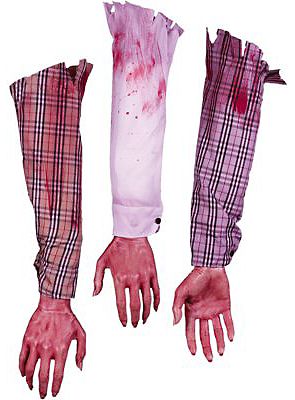

Another Right Wing Bombing
April 30, 1981, the Riocentro bombing ends up killing sergeant Pereira do Rosário and hurting captain Machado both from Brazil’s armed forces’ intelligence unit. The bomb went off early in the parking of the Riocentro convention center. It was destined to go off with other bombs during a concert with Caetano Veloso and Gilberto Gil when 20,000 people celebrated May Day. The incident, never fully investigated, occurred at a turning point in Brazil, after the huge metal workers’ strikes at the end of the 1970s, (later-president) Lula founding the PT and soon after going to prison. During General-President Figueiredo’s (‘the last dictator’) mandate, from 1979 to 1985, Brazil goes into a deep recession and he will be remembered as the worst leader the country ever had. Leaving power he says: “I want people to forget me.”
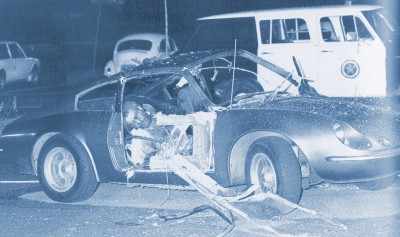
The Bologna Massacre
In Bologna, a terrorist attack at the central train station kills 85 and wounds 200. The event will become known as the Bologna Massacre. At 10:25 AM, with the train station filled with tourists, a time bomb— constructed from TNT, T4 and compound B—detonates in a suitcase placed inside a waiting room. The explosion destroys most of the main building and reaches the Ancona–Chiasso train waiting on the first platform. The roof of the waiting room collapses onto the passengers, increasing the total number of casualties. The city is unprepared for such a catastrophe. Ambulances are overwhelmed by the number of victims, and buses and taxis are enlisted to transport the injured to hospitals.
Blame for the attacks is placed on the neo-fascist terrorist organization Nuclei Armati Rivoluzionari. General Pietro Musumeci, second in command of the military intelligence agency SISMI and—as will be revealed in 1981—a member of the P2 Masonic lodge, will forge evidence in order to charge two leaders of Terza Posizione in exile with the crime. The exiles accuse Musumeci of trying to divert attention from Propaganda Due and Licio Gelli, head of P2. In 1988, four neo-fascists will receive life terms: Valerio Fioravanti, his wife Francesca Mambro, Massimiliano Fachini, and Sergio Picciafuoco. Leader of P2, Licio Gelli, Francesco Pazienza, Pietro Musumeci, and Giuseppe Belmonte, receive sentences for slandering the investigation.
In 1990, an appeals court cancels the convictions of the four neo-fascists, as well as those of Gelli and Pazienza. A retrial is held in 1995 and the Corte di Cassazione issues the final sentence, upholding the life sentences for the neo-fascists and members of the Nuclei Armati Rivoluzionari, and convicting Gelli, Pazienza, and the SISMI officers of investigation diversion. In 2004, Luigi Ciavardini, who was 17 years old at the time, receives a 30–year prison sentence for his role in the attack and the subsequent assassination of Judge Mario Amato in June 1980. In 2006, the lawyer of Argentine AAA (Alianza Anticomunista Argentina) member Rodolfo Almirón declares that it is ‘probable that Almirón participated—along with Stefano Delle Chiaie and Augusto Cauchi—in the 1980 bombing in Bologna’s train station.’ However, the Argentine Supreme Court refuses, in 1998, to extradite Cauchi to Italy. In 2008, former Prime Minister Francesco Cossiga alleges that PLO-affiliated terrorists from George Habash’s Popular Front for the Liberation of Palestine were responsible for the bombing. PFLP denies responsibility.
In view of the SISMI and P2 involvement, as well as the right wing affiliations of the offenders, it is believed that the attack was carried out within the scope of the ‘strategy of tension’ in which terrorist attacks by far-right militant organizations were staged by internal state operatives to convince the populace to accept more authoritarian exercises of government power.
Such strategies have been identified with the top secret NATO stay-behind operation Gladio.
In Italy, the August 2, will be designated as a memorial day for all terrorist massacres. The station will be reconstructed, but the flooring and a deep crack in the main wall will remain untouched. Moreover, the station clock will be forever stopped at 10:25, the exact time of the explosion.
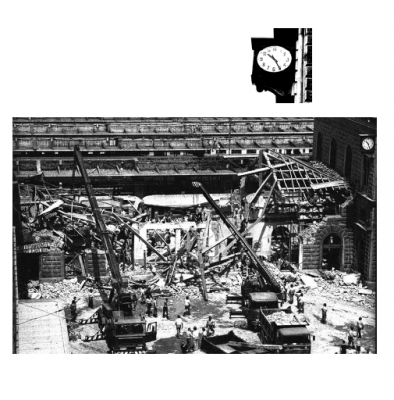
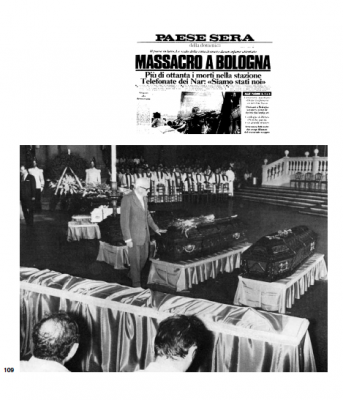
I like the drawings on the floor.
More than a model-model. I think we should create a situation. Columns of wisdom/whispering could work.
Answers more than questions. The answers though don’t have to be true.
What do we repeat today?
Is it the NSU? Many same coordinates (involvement of services/ non-interest of police) suicides and deaths of important witnesses.
As Don DeLillo pointed out in MAO II and what the German Baader Meinhoff Group did so well is producing images. Images of destruction in the news which recall atrocities (like those in Vietnam) but re-enacted in front of our own door.
These were not the images right wing groups would want to create. Anyway the right wing affiliations of the Oktoberfest offender(s) suggests that the attack was carried out within the scope of the ‘strategy of tension’ (in which terrorist attacks by far-right militant organizations were staged by internal state operatives to convince the populace to accept more authoritarian exercises of government power.
Blame the left.
Such strategies have been identified with the top secret NATO stay-behind operation Gladio. Bologna train station a few weeks before the Munich bombing. Right-wing extremists killing 85 people. Munich papers receive calls claiming responsibility from ‘right wingers in Bologna.’ Tobias von Heymann found reports in the archives of East German intelligence, STASI, which make a connection between Gladio, NATO Stay Behind agents, and the Oktoberfest bombing.
Why does nobody talk about Gladio’ involvment now?
The new witness talked about men following her in cars.
The Oktoberfest in Munich is a hedonist and decadent beer festival just to get drunk, to get laid, to party in traditional costumes. All these foreigners having so much fun. Imagine the loser Köhler going around and hating all this. Like an Islamist.
Besides the analyses going on about ISIS that they only recruit Losers I think there is also this romantic idea of being a terrorist, give meaning to your life, fighting for the right thing. But as Zizek pointed out ISIS only fight their own temptation. What did/do the right wingers fight? For the Vaterland, against Communism, the Left. Or their temptations.
Jean Baudrillard:
a) In this system, death itself shines by virtue of its absence. (The Bologna train station, the Oktoberfest in Munich: the dead are annulled by indifference, that is where terrorism is the involuntary accomplice of the whole system, not politically, but in the accelerated form of indifference that it contributes to imposing.) Death no longer has a stage, neither phantasmatic nor political, on which to represent itself, to play itself out, either a ceremonial or a violent one. And this is the victory of the other nihilism, of the other terrorism, that of the system.
There is no longer a stage, not even the minimal illusion that makes events capable of adopting the force of reality — no more stage either of mental or political solidarity: what do Chile, Biafra, the boat people, Bologna, or Poland matter? All of that comes to be annihilated on the television screen. We are in the era of events without consequences (and of theories without consequences).
On Nihilism, 1980
Jean-Louis Bruguière:
80*81: You also found a connection to the attack in 1980, on the Oktoberfest in Munich?
Jean-Louis Bruguière: We were sure that the terrorists of the Rue des Rosiers had contacts with the extreme right and the Nazi groups. The DGSE, the Diréction Générale de la Sécurité Extérieure, the French external intelligence agency, passed me the information that two of the attackers had striking similarity to two German neo-Nazis, Walter Kexel and Odfried Hepp. Hepp was trained by Fatah in a camp in Lebanon, from June 1980 until July 1981. Their antisemitism and antizionism went well with the Palestinian movement. He called himself ‘Youssouf’ and tried to set up a PLO cell in Frankfurt. He is a strong suspect for the bombing in Munich that killed 13 people.
80*81:
Jean-Louis Bruguière was the most important “juge d‘instruction”, as these clandestine researchers are called in France. He became a judge in 1973. He was dealing with local criminal affairs in Normandy. He moved to Paris in 1976, still in charge of small affairs. He transferred to organized crime in 1978 and in 1981 his career exploded. In 1986 he formed an anti-terrorism division in Paris. A year later his apartment was targeted in a grenade attack; Bruguière continued his fight. In 1994, he captured Carlos the Jackal, one of world’s most wanted terrorists. Possibly his biggest case was that of UTA Flight 772 which was sabotaged over the Sahara Desert in 1989 with the loss of 170 lives. Bruguière had six Libyans prosecuted in Paris and convicted in absentia. In 2004, at the height of his career, Bruguière was appointed vice-president of the Paris Court of Serious Claims. He was responsible for the indictment of Rwandan president Paul Kagame for the assassination of Juvenal Habyarimana in 1994. In 2007, Bruguière left his civil function as a magistrate and became a candidate for Nicolas Sarkozy’s UMP conservative party. He was defeated by his Socialist competitor.
I think we should overload with images. Make a wall like the walls in Homeland or The Wire. Pin images together as if we look for traces. But these images are all screwed up. They might make sense, but in a different way. Like the blog that Christopher did totally makes sense in a different Godardian way. Take a look: http://www.8081.biz/ There is such a nice element of the unknown in all of this which. We could recreate this misunderstanding.
We spoke about walking around/inside the stories. We discussed presence and again scale. We agreed, size matters but is somehow relative. It depends on memory, on understanding, so also on language, politics and translation. So maybe size is personal and the stories’ presence should reflect that and possibly play with it too, mix things up. Logically 85 > 13 > 1 but maybe 1 > 85 < 13.
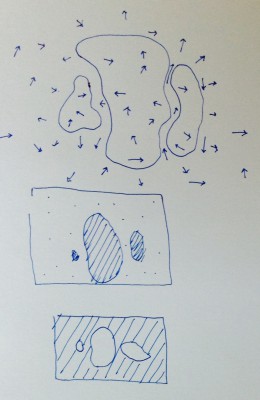
Phrases could (literally) outline each story, that would outline a memory hence an event. Our lines will be like traces(of each story) in memory, somewhat vague but still very present. We outline this void.
Almost similar to how a chalk outline (temporarily) marks evidence at a crime scene to preserve evidence. Surely ‘happier’ outlines exist. Like Keith Haring’s murals of technicolor, traces of forever dancing silhouettes.
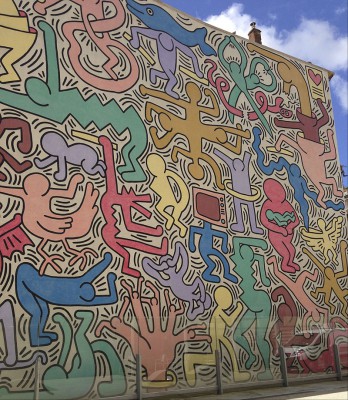 tuttomondon; keith haring 1989 mural in Pisa
tuttomondon; keith haring 1989 mural in Pisa
We spoke about forgotten details, again the cigarettes, the fingers (or lack of), those triggers …surely there are more.
We could walk around/inside it. We could listen to the story in a language we might not comprehend but simultaneously read about it in BIG BOLD PRINT or in tiny tiny type somewhere else. We connect the shape with the sound and we mix things up but we remember. Also, what do we take away? What does this leave us with? Possibly new traces?
Still, what is the colour? What is outside? What draws the line? Is there a pattern?
This is how it could start. This is how it could be.
So after Alexine and I have met, the following suggestion/thought – there is a common link in a lot of narratives about bombs and assassinations, the “loner”. We seem to want this narrative, we seem to need it. It makes more sense that somebody might kill alone, it is more comforting. There is, of course, a motive for that; and in the case of the Oktoberfestattentat, it totally worked. The event is more or less erased from memory. 13 deaths. It could have been a major crisis. But nothing. First they blame it on the Left, like the Italians did it in Bologna. Then they blame it on a “verwirrter junger Mann”, a sort of delusional young man, the eternal outsider. This drains all the politics out of these actions. This leaves us with carnage. So best fast forget it, fast forward. Bologna is still remembered. Munich is not. Alexine remembers the assassination of Karin Grech. What is the size of memory? What is the shape of death? How can we even grasp what has happened? What is the color of catastrophe? So maybe we do it like this: Three stories in one room, Karin Grech, Gundolf Köhler, Gladio and its role in the Bologna blast. Three languages. Three sites of death. The years 1980 and 1981 were bloody years. There were a lot of dead, a lot of people shot, Reagan, Lennon, there were demonstrators shot in the streets of San Salvador. What do you do with these images, with these stories? How can you access them, store them? We reenacted some of these in yoga positions for the opera we did in Munich. This time we try something else. How can we change the size and shape of memory?
That is an excellent point. Why is Bologna such a memorable event, a strong mark in the history of post-war Italy and a turning point in the political self-understanding of the country – and the Oktoberfestattentat is something like folkloristic, something weird and Bavarian, no context, no narrative that puts the event into a perspective. It was quickly diminished in size and relevance. How could this happen? Everything was there to produce a scandal of sorts. Pictures, dead, a more than popular site. It was a bit like tearing out the heart of Munich. But things were settled fast. This was a political decision by the Strauß government. But why did it work? How did the early-eighties iconographic memory work or not work? As Alexine says, maybe size does matter, for a model, for the dead. 85 versus 13. 85 versus 13. 85 versus 13. Or is there just no narrative for right-wing terror? Just like there is no narrative for right-wing thinking. This is, by the way, what made the other deadly series of right-wing murders possible, the terror trio of the NSU. You need a story to find what you are looking for. This is a paradox. This is politics. How could it happen?